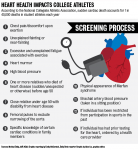At the age of 15, Sameer Jafri accidentally became the poster child for sudden cardiac death awareness.
Jafri said he was approached by a photographer with the Eric Paredes Save a Life Foundation while waiting in line to get a screening for heart abnormalities after baseball practice.
“A photographer saw me standing in line in my uniform and grass stains and took a photo of me, and it ended up on pamphlets and a website,” Jafri said.
Jafri, a third-year international development studies student, progressed from poster child to health proponent when he launched the UCLA chapter of the nonprofit Saving Hearts Foundation in November 2014. The organization offers free electrocardiogram screenings, informs students about heart abnormalities and places life-saving automated external defibrillator devices in high schools, Jafri said.
He added the Saving Hearts Foundation focuses on 12- to 24-year-old athletes, the age group most at risk of sudden cardiac death because of their physically demanding training regimes.
“I think all athletes have this feeling that they’re invincible and can beat anything,” Jafri said. “But heart disease is something you can’t beat on your own, and it can happen to anyone at any time.”
The Saving Hearts Foundation conducts one electrocardiogram, or EKG, screening every quarter at local high schools in Los Angeles, he said. An EKG is a five-minute procedure that involves hooking up electrodes to the skin to detect problems in the electrical activity of the heart.
The Saving Hearts Foundation’s most recent event was at Bonita High School in La Verne, California, on April 30, where the organization screened 170 students and identified 17 students who needed cardiac followups, Jafri said.
He added they found a student who had Wolff-Parkinson-White syndrome, which required he undergo a heart surgery to prevent fatal injury, at their winter quarter screening at Long Beach Polytechnic High School.
“Every abnormal incident we have found so far has been manageable,” Jafri said. “But if the abnormalities weren’t found, these athletes could go from running on the court to hitting the ground – fast.”
Devin Lawson, a first-year business economics student, said he joined Saving Hearts Foundation because he had open heart surgery during his first year in high school.
Lawson said he thought he was a completely healthy high school baseball and soccer player, until EKG results at his routine physical revealed he had an atrial septal defect. This disorder, he said, could lead to sudden cardiac death if left untreated.
“It just came out of the blue that I had this hole in my heart,” Lawson said. “I could run the whole soccer field. I was in great shape and there were no warning signs that anything was wrong with me.”
Lawson said he thinks student-athletes often expect think they will be shunned to the sidelines if they are diagnosed with a heart abnormality, but he said he was able to return to sports without complication just three months after his surgery.
Matt Dickerson, a defensive lineman on the UCLA football team who has volunteered at Saving Hearts Foundation’s screenings, said heart abnormalities should be treated with as much attention as any other physical condition among student-athletes.
“Concussion injury is the leading concern for a lot of athletes and parents in football and other sports because it’s so easy to see happen,” said Dickerson, a second-year sociology student. “Heart problems tend to go under the radar.”
John DiFiori, head team physician for UCLA Athletics, confirmed there have been cases of serious heart abnormalities in UCLA athletes. He said he could not disclose the frequency of these cases due to patient confidentiality, and that there have been no incidences of sudden cardiac death.
DiFiori said the UCLA’s heart health screening criteria follows procedures outlined in the American Heart Association’s screening process and the American Academy of Pediatrics’ preparticipation physical evaluation form. The criteria include checking athletes for heart murmurs, abnormalities in blood pressure and family history of heart disease during their annual physical examinations.
EKGs, however, are not a required component of the physical exam screening procedure. Dr. Richard Shemin, chief of cardiac surgery at the Ronal Reagan UCLA Medical Center, said this is due in part to the fact that EKGs are considered cost inefficient.
“I would like to see EKGs and echocardiograms as a requirement,” Shemin said. “But (we would spend) millions of dollars on these screenings, and sometimes they pick up on abnormalities with a false positive.”
Christian Wooten, a third-year sociology student who volunteers with the organization, said the Saving Hearts Foundation is proposing legislation that would make EKGs a requirement at physicals. He said young students – and student-athletes especially – are often perceived as the healthiest members of society, so people may ignore the fact that sudden cardiac arrest can affect anyone.
“EKGs are not part of the required annual physical because heart abnormalities are seen as this adult problem,” Wooten said. “If we can find just one student athlete with a heart abnormality, that’s one more life that can see another day.”
